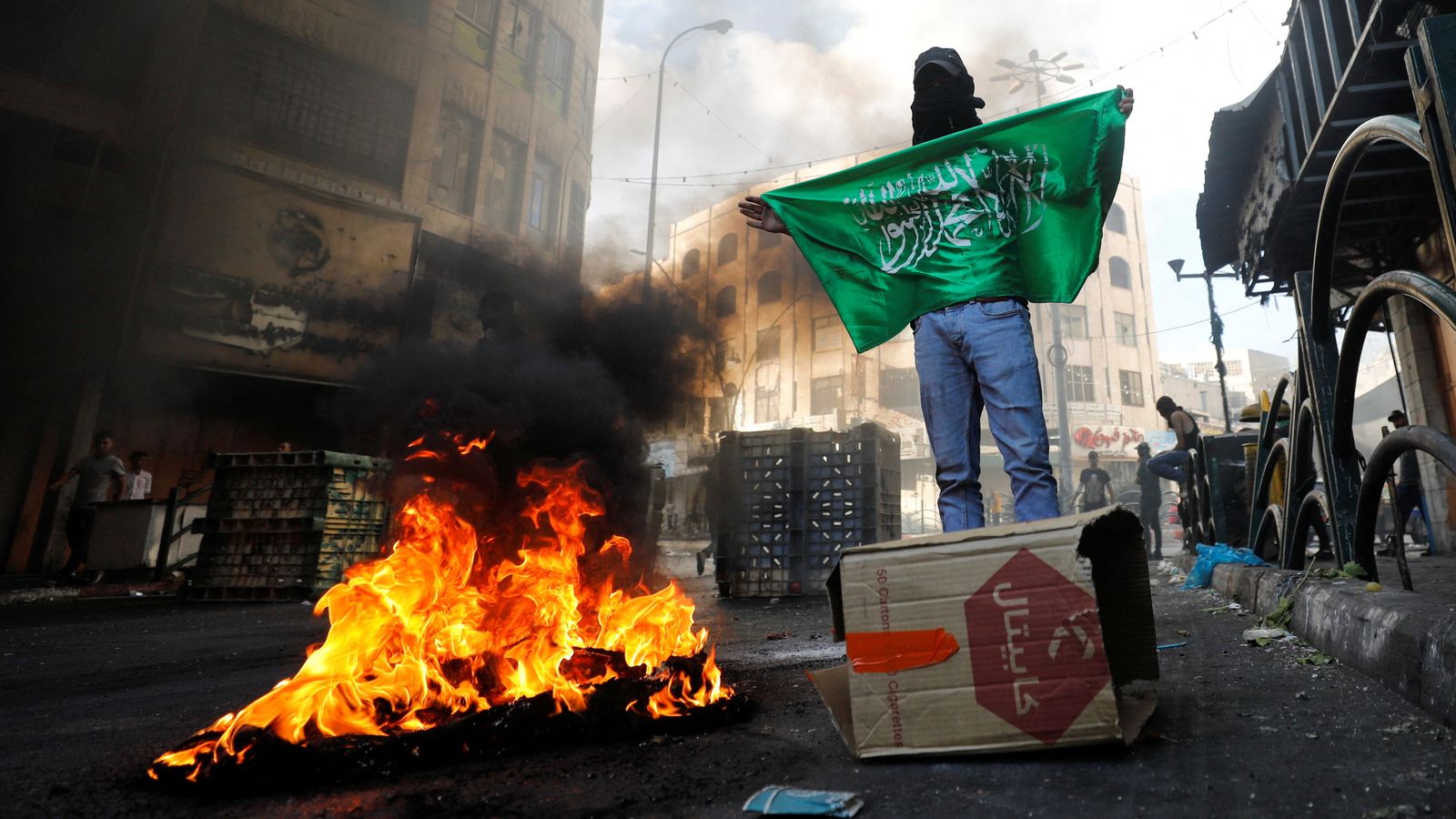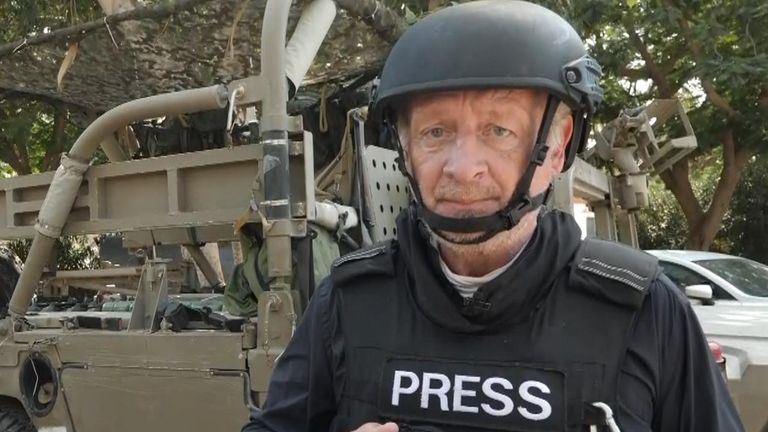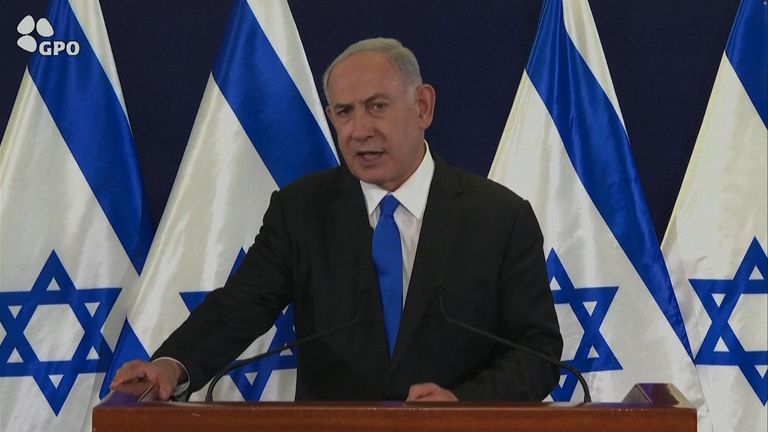The conflict between Israel and Palestine is one of the bloodiest and longest-running in the world. There are intense feelings on both sides after decades of tragedy and numerous failed bids for lasting peace.
Land that has been fought over for centuries has once again seen bloodshed with the attack by Hamas militants at the weekend and Israel’s relentless bombing of the Gaza in response.
Explaining the origins of the bitter conflict is difficult.
In this story, Sky News seeks to examine some of the key events of the last 100 years in shaping that part of the Middle East – and why peace remains so elusive.
To do so we have spoken to an academic expert as well as drawing on the experience of our Sky News foreign correspondents.
Turn of the 20th century
“It’s such a deeply rooted conflict,” Professor Eugene Rogan, an expert on modern Middle Eastern history at the University of Oxford, says.
He told Sky News that in a classroom he would begin by telling students about the 1880s and the beginning of Jewish immigration to the region inspired by the idea of a Jewish state.
“They establish townships and colonies and settlements… try and create a new Jewish community in Palestine to add to the established Jewish communities of Sephardic Jews who have been living in Palestine for centuries and centuries.”
Professor Rogan says the key point here is that in 1917 the British government itself endorsed the idea of a Jewish national home – not a state – in Palestine with the Balfour Declaration.
It followed a secret treaty signed between Britain and France during the First World War defining their agreed spheres of influence in a post-war partition of the Ottoman Empire.
The British are relevant because, in the aftermath of the First World War, control of Palestine was handed over to Britain in the form of a ‘mandate’.
“They set in motion demographic change,” Professor Rogan says.
Amid rivalry over who would claim statehood over Palestine, an Arab revolt between 1936 and 1939 broke out and was violently suppressed by the British.
After the Jewish community also revolted against British rule, the mandate for Palestine was handed over to the newly formed United Nations after the Second World War.
Creation of the state of Israel and 1948 war
In 1947 – two years after the end of the Second World War and the horror of the Holocaust – the UN General Assembly voted to partition Palestine into an Arab state and a Jewish state, against significant opposition.
“That set in motion a civil war in Palestine between the Arab and Jewish communities,” Professor Rogan said.
In the run-up to the British withdrawal from the area, Jewish and Arab militias clashed – resulting in the loss of Arab Palestinian towns to the Jewish community.
In May 1948, Britain withdrew and the armies of various Arab states responded by invading.
When hostilities in the first Arab-Israeli war ended in January 1949 the new state of Israel was in possession of 78% of the territory.
The West Bank, East Jerusalem and the Gaza Strip remained in Arab hands.
Read more:
How Hamas attack on Israeli festival unfolded
Analysis: Israel will be looking at all military options
How the Israel-Hamas war broke out
The Six-Day War and two sets of accords
In 1967, Israel made a pre-emptive strike against Egypt and Syria, launching the Six-Day War.
The rapid conflict saw Israel capture not just the rest of mandate Palestine – all of Jerusalem, the West Bank and the Gaza Strip – but also the Golan Heights from Syria and the Sinai peninsula from Egypt.
Despite the later withdrawal of Israeli forces from the Gaza Strip and some degree of self-governance in the West Bank, the two areas remain known as the Occupied Palestinian Territories to this day.
In 1973, Egypt and Syria attacked Israeli positions along the Suez Canal and Golan Heights, beginning the Yom Kippur War.
Israel pushed both armies back within three weeks.
In 1979, following secret negotiations the year before, Israel and Egypt agreed to a peace treaty.
Israel agreed to return the Sinai peninsula to Egypt in return for normal diplomatic relations with Cairo, among other conditions.
This was unpopular with other Arab states and Egypt was subsequently suspended from the Arab League for 10 years.
Click to subscribe to the Sky News Daily wherever you get your podcasts
Amid anger at occupation and what Palestinians felt was repression by Israeli authorities, two Palestinian organisations emerged that would change the region: the Palestine Liberation Organisation (PLO) and Hamas.
The Oslo Accords in 1993 – negotiated between Israel and the PLO led by Yasser Arafat – saw the creation of the Palestinian National Authority which was to have some degree of autonomy within the Gaza Strip and the West Bank.
Conflict with Hamas
Professor Rogan said: “With the return of a Palestinian authority to Jericho, later Ramallah and the Gaza Strip, you see these territories emerging from Israeli control into the control of a Palestinian authority.”
He described how the lack of a land bridge between the two territories saw them go on “very different trajectories”, with the Islamic forces headed by Hamas becoming predominant in the Gaza Strip and Arafat’s Fatah movement – dominant in the PLO – predominant in the West Bank.
In 2005, Israel left the Gaza Strip, which it had captured from Egypt in 1967.
Hamas prevailed in 2006 elections in the territory and the following year engaged in an armed conflict with the Palestinian Authority, resulting in the Gaza Strip essentially breaking away.
“From 2007 to the present day it’s been a series of conflicts between Israel and Gaza, with Israel no longer occupying Gaza, but controlling all of its frontiers, except those with Egypt,” Professor Rogan said.
Egypt, in turn, has since imposed a blockade on its side of the Gaza Strip.
On 7 October 2023, Hamas launched a devastating attack across the border into Israel.
In retaliation, Israel began an intense bombardment of the Gaza Strip.
Thousands of people have since been killed and it is unclear what the lasting effect on the region will be.
What are the main enduring Israeli-Palestinian issues?
Ongoing issues dividing Israelis and Palestinians include: a two-state solution, Israeli settlements, the status of Jerusalem, and refugees.
The two-state solution would be an agreement to create a state for the Palestinians in the West Bank and Gaza Strip alongside Israel.
Hamas is sworn to Israel’s destruction, recognising 1967 borders but not the state of Israel.
Israel has said a Palestinian state must be demilitarised so as not to threaten Israel.
Israel has been repeatedly criticised by the international community for building more and more settlements in the occupied West Bank.
Many countries view these as illegal, but Israel disputes this.
The status of Jerusalem – a city that has been fought over for centuries – is likewise a point of bitter contention.
Click to subscribe to the Sky News Daily wherever you get your podcasts
Many Palestinians want East Jerusalem, which includes sites sacred to Muslims, Jews and Christians, to be the capital of their state.
Israel claims the whole of Jerusalem as its capital, though this is not widely recognised on the world stage.
Around 5.6 million Palestinian refugees – mainly descendants of those who fled in 1948 – live in Jordan, Lebanon, Syria, the West Bank and the Gaza Strip.
About half of registered refugees remain stateless, according to the Palestinian foreign ministry, with many living in crowded camps.
Palestinians have long demanded refugees should be allowed to return, along with millions of their descendants.
But Israel says any resettlement of Palestinian refugees must occur outside of its borders.
This story originally appeared on Skynews



![- FILE PHOTO MAY 1948 - Israeli troops in action near an unidentified Arab village in the Galilee region during the opening stages of the 1948 War of Independence.[ David Ben Gurion, Israel's founding father, declared Israel a state on May 14, 1948, hours before the termination of the British Mandate in Palestine was due to end. The following day the armies of Egypt, Syria, Jordan and a contingent from Iraq attacked the new state.] Israel celebrates its 50th Golden Jubilee anniversary on April 3](https://e3.365dm.com/23/10/768x432/skynews-israel-palestine_6318454.jpg?20231011174116)





